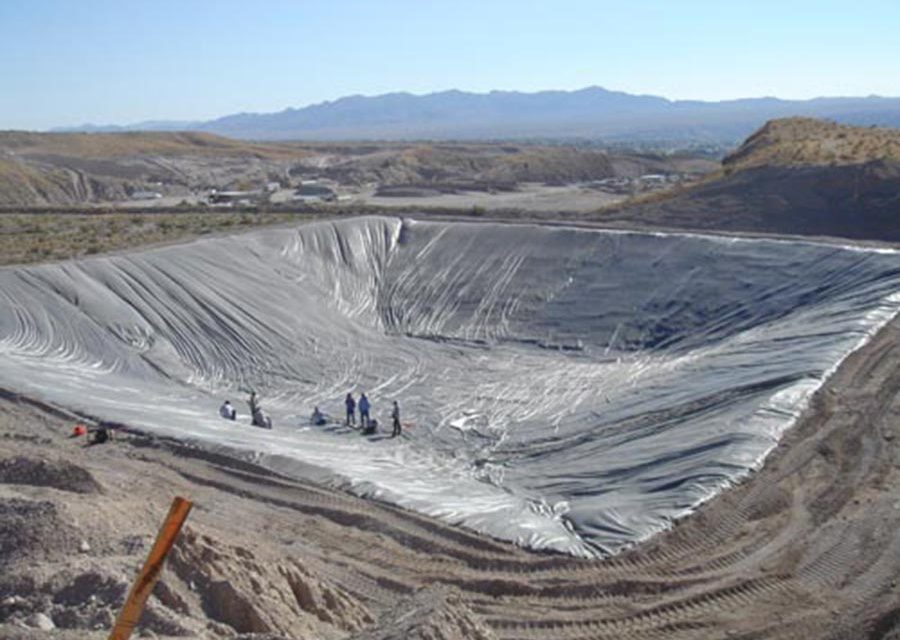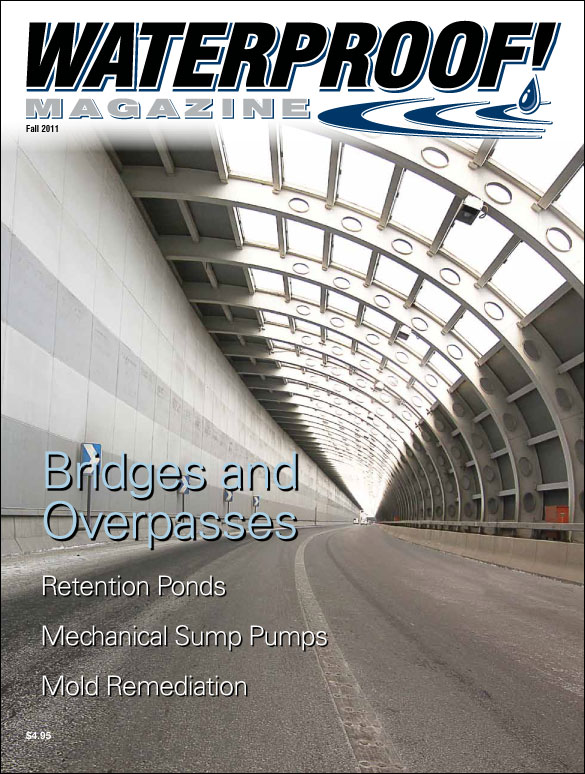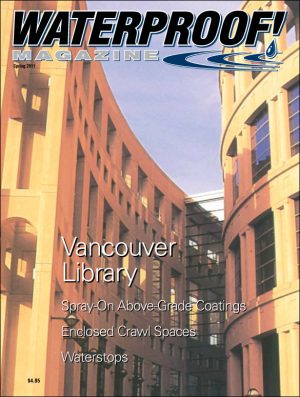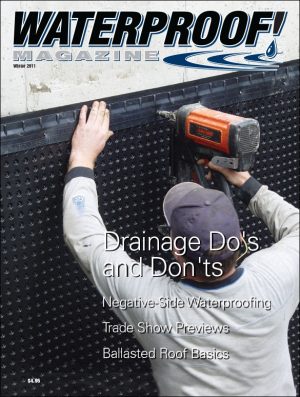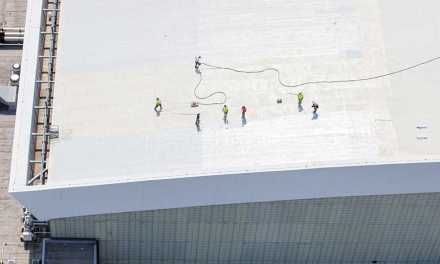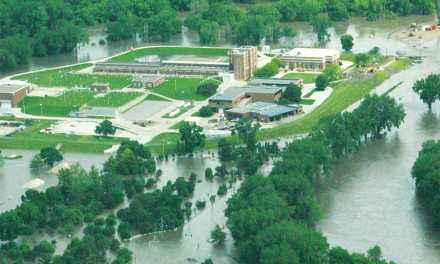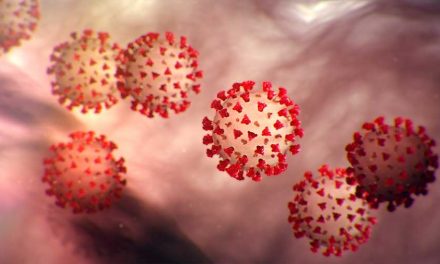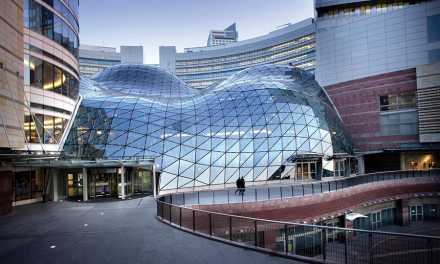Ponds can be as small as a backyard water feature or as massive as this oil well waste pit. Either way, the goal is the same: to keep the contents from leaking into the ground.
Retention ponds are used for storing everything from stormwater to mining slurry.
Stormwater retention ponds are usually built with a pervious bottom, and are designed specifically to allow water to trickle into nearby streambeds or percolate into the underlying aquifer.
However, other ponds can contain toxic chemicals and pollutants. Examples include coal slurry pits, sewage lagoons, even ordinary landfills. These applications require liners that will remain absolutely waterproof despite the often corrosive nature of the contents.
John Henningsen, marketing manager at Rhino Linings Incorporated, explains, “Waterproofing is needed to in wide variety of applications that require the containment of water, chemicals or waste. These structures are specified by dozens of industries from petrochemical loading stations, tank farms, nuclear plants, wastewater treatment facilities, mines, fisheries, and commercial buildings.”
Whether the liner is installed to prevent contaminants from entering the groundwater or just to conserve potable water resources by preventing seepage, the waterproofing technology is similar.
Shane Carter, division manager for Western Environmental Liner, says, “There are several options for waterproofing liner materials. Normally, choosing the best product for the application has to do with how long the liner will be needed, how rough the material will be handled, and what the liner will be containing.”
Other considerations include the size of the job and the nature of the pond contents. A small residential water feature holding 200 gallons of clean water will have different requirements than a mine tailings pond holding millions of gallons of toxic chemicals.
Common liner materials include poly-vinyl chloride (PVC), EPDM rubber, high-density polyethylene (HDPE) and Bentonite geomembranes.
PVC Liners
The most commonly specified lining is PVC. It has excellent abrasion resistance and is difficult to puncture. It’s also highly flexible, which allows the liner to conform precisely to the subgrade. It’s easy to seam and seal, and is resistant to most common industrial chemicals. Finally, PVC liners are among the most cost-effective.
The only major drawback to PVC liners is that they’re easily damaged by the sun’s ultraviolet (UV) rays. A PVC liner covered with at least 12 inches of clean fill will last for decades.
PVC is available in a variety of thicknesses. For pond and pit liners, thicknesses of 20 mil, 30 mil, 40 mil and even 60 mil are commonly available.
PVC liners are also available with specific chemical additives for certain pond liner tasks. A special oil-resistant formulation is available for use in emergency containment barriers at refineries and gas stations. Oil -resistant PVC is also suitable for lining ponds that contain drilling waste, coal ash slurry, and fracking fluid. The “fish grade” PVC (used by fish hatcheries and city parks) has specific chemicals omitted to ensure the water remains healthy for aquatic life.
EPDM Liners
EPDM rubber is also a very common material. It’s more expensive than PVC, but for small residential applications such as water gardens and goldfish ponds, it’s by far the most popular option.
Unlike roofing EDPM, the EPDM pond liner material is algaecide and fire retardant-free, so it’s 100% fish safe and plant friendly.
EPDM is easy to seam and easy to patch—accounting for its popularity with do-it-yourselfers. The material is a type of rubber, so it can be installed in virtually any climate or temperature condition, and can stretch to triple its original length without breaking, so sub-par subgrades are not an issue.
Finally, EPDM liners offer unmatched resistance to ultraviolet radiation and can withstand normal environmental exposure for well over 30 years.
As for commercial applications, Carter says, “We normally recommend EPDM for smaller areas—those under 50 feet in both directions—because EPDM comes in rolls 50 feet wide and narrower and EPDM does not melt together like many liner products. Beyond 50 feet, seaming is needed, and the glue and tape for EPDM can be very expensive. It’s also not as reliably waterproof as a melted seam, so we don’t normally recommend it for large areas and non-recreational applications.”
Polyethylene Liners
For extreme conditions, ponds are sometimes lined with high-density polyethylene. HDPE is not very flexible—it’s the same stuff milk jugs and margarine tubs are made from—but it’s incredibly tough.
HDPE is usually UV-stabilized, and offers exceptional dimensional stability, outstanding tear resistance and seam strength.
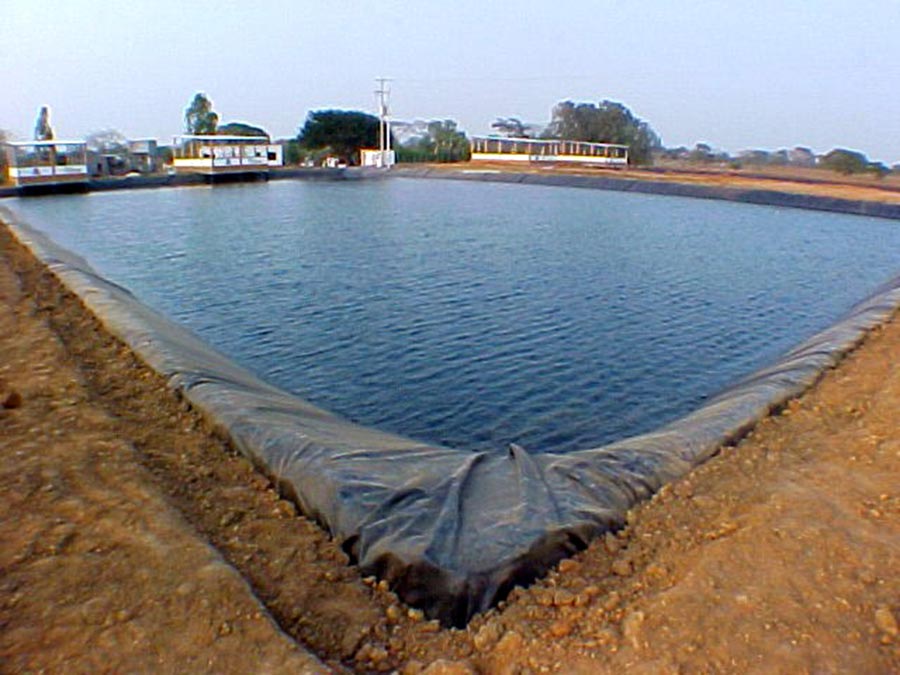
Polyethylene liners, such as the Permalon product used on this fish pond, are exceptionally durable and long lasting.
The drawbacks are the cost and the product’s stiffness. Carter admits, “HDPE can be a very tough product due to its almost cardboard consistency.” He notes that the product is difficult to seam together in the field, and unreinforced HDPE has a tendency to crack.
But a number of liner manufacturers have developed innovative solutions that completely overcome these drawbacks.
For example, Reef Industries makes Permalon, a “unique cross-laminated high-density polyethylene membrane” specifically for pond liner applications. Jeff Garza, sales manager for Permalon, says, “The product is lightweight, highly flexible and easy to handle, yet offers tear and puncture resistance for the most demanding applications. They have the greatest tensile strength to weight ratio available.”
Permalon is available in a range of weights, thicknesses and formulations, and Garza says it’s ideal for lagoon liners, secondary containment systems, and decontamination pads, noting that the company has large sheets and standard rolls in stock for immediate shipment.
Raven Industries also makes a line of HDPE pond liners specifically for the mining industry. The product has a heavy-duty reinforcement grid sandwiched between two sheets of HDPE film to eliminate the possibility of cracking. Dubbed the Dura-Skrim K-series, they’re used for leachate ponds, heap leach pad liners, and tailing ponds. Available in two thicknesses, 35 mil and 45 mil, Raven claims it will outperform liners that are twice as thick.
Cheryl Butler, a marketing executive at Raven, says the company can custom fabricate large one-piece drop-in liners that eliminate all seams.
Polypropylene Liners
Raven also makes a line of polypropylene (PP) pond liners.
Polypropylene is more expensive than PVC and HDPE, comparable in price to EPDM. It is, however, one of the more durable liner materials; it can last up to 40 years.
Reinforced polypropylene has excellent tear and UV resistance and is highly chemically resistant. Western Environmental Liner sells reinforced PP in a potable grade for drinking water. The excellent properties of Reinforced Polypropylene allow it to be used for almost any lining application, including canal liners, golf water hazards, waste containment Liners, reservoirs and mining applications.
The main advantage of polypropylene is that it comes in huge sheets. Where other materials can be limited in width, single–piece PP liners larger than 50’ x 100’ are common. The material can also be heat seamed together.
Other Materials
A few other materials have been used as pond liners.
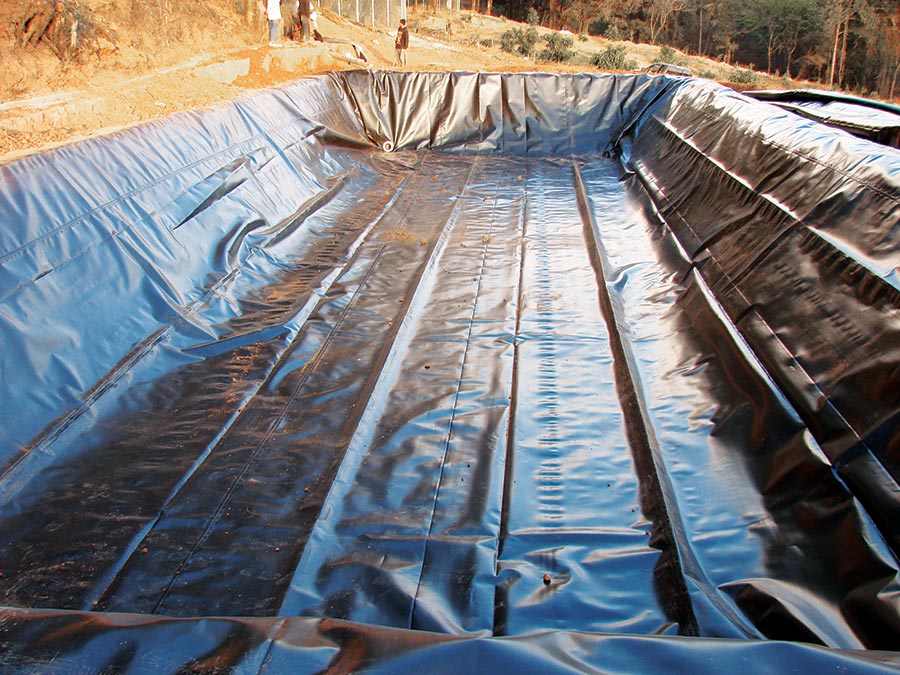
Even large liners can be installed as a single piece. The prepared site should be free from sharp rocks and debris, and the side slope should not exceed 3:1. Burying the edge of the liner in a trench (far right) is a common way to secure the membrane.
The lining technologies business unit of CETCO has marketed geosynthetic clay liners for years. Sarah Esp, marketing manager at CETCO, says “We offer a full range of engineered environmental liner systems including geosynthetic clay liners, pond liners, and bentonite soil sealants.” Esp says CETCO lining products are often used for stormwater basins, agricultural operations, landfill liners, and secondary containment vessels. Like all bentonite products, these pond liners work because they swell in the presence of water, sealing off cracks and leaks.
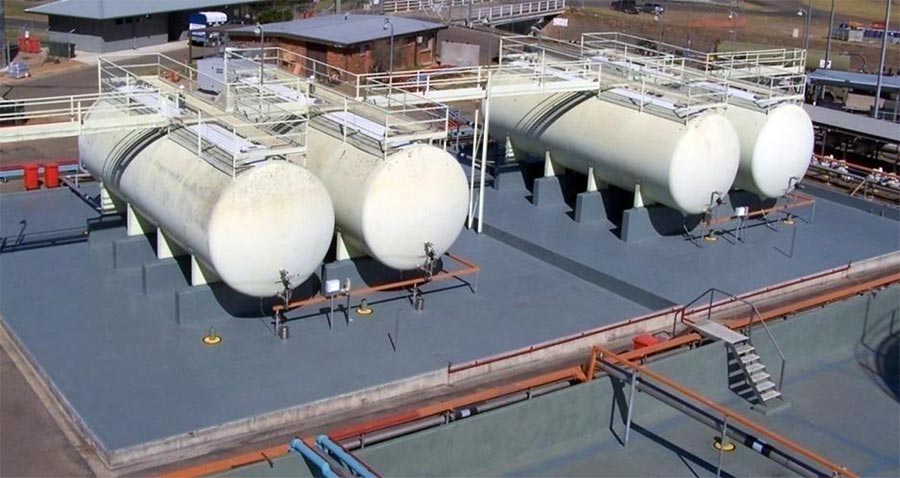
For irregular surfaces such as this secondary containment system at a petroleum refinery, spray-on linings offer may advantages.
Rhino Linings makes a tough spray-on coating that has proven effective in a wide range of applications. Henningsen, the Rhino marketing manager, says, “Engineers have traditionally used solvent-based or asphalt type products – many times used with fiberglass or polymer sheet goods to form seamed barriers, [but many] engineers and facility owners are moving away from that technology. There are also water-based polyurethanes that are good, but they take a long time to cure and slow down the overall construction schedule.
Rhino Linings manufactures a range of 100% solids (Zero VOCs/Solvents) spray-applied products—polyurethanes, polyureas and hybrids—for application on concrete, steel, wood, foam, and geotextiles.
“These coatings form a seamless, monolithic membrane that is completely bonded to the substrate and allow the applicator to quickly and easily build up any thickness required,”
Henningsen continues. “A water-proofing/containment project can be turned about in a matter of minutes since the coatings cure to the touch in just seconds.”
Finally, some concrete-lined vessels are sealed using integral waterproofing. Les Faure, marketing manager at Xypex, says his company’s integral waterproofing product is commonly specified in sewage treatment plants, for both new construction and repair. Faure admits that integral admixtures are better suited for concrete tanks than open ponds, but points out that they are completely impervious to chemicals such as hydrogen sulfide that present problems for other membranes.
Making a Choice
When it comes down to choosing a material, Carter at Western Liner says, “We normally recommend reinforced polypropylene, reinforced polyethylene or PVC based on the application. These products can be bonded together with simple heat, enabling these products to be made in large panels in the factory to cut down on field welds. They are all flexible enough to be put on pallets for easy shipping.”
Factory fabrication ensures better seaming and faster installation. Crews can install literally acres of lining per day, reducing overall construction time.
“Longevity is the most important factor, and thickness doesn’t equate to quality,” he warns. There are a lot of projects that may run as little as a year or two, or a moderate time frame of five years, or longer term such as 20 years or longer.”
Installation
Site conditions can be a determining factor as well. Rocks, over time, can needle through almost any liner material no matter how strong it is, so if the substrate is rocky, plans should call for a geotextile layer or a sand barrier to prevent puncture.
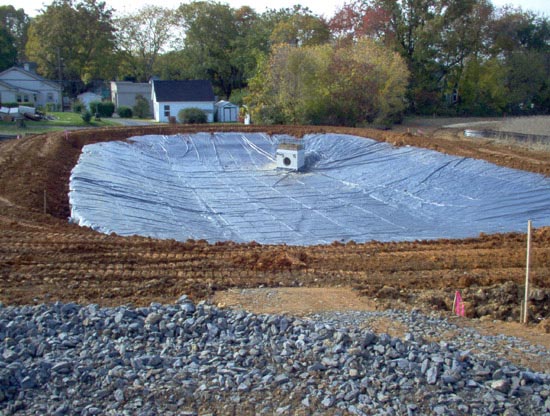
The choice of material will likely be determined by the nature of the application. Residential ponds that hold clean water and are applied over a smooth base (above) require an entirely different approach than commercial applications expected to contain corrosive chemicals, seal multiple penetrations, and withstand extensive foot traffic (below left).
Normally the installer company has the ability to put in a one-piece liner. Once it arrives from the factory, all they need do is unroll the liner and put in place.
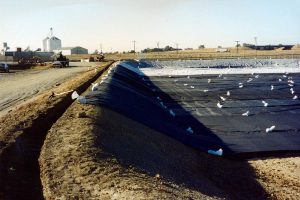
If job size, material weight and site conditions mean a multi-piece liner is necessary, experienced crews can weld panels together in the field. The typical limit for a one-piece liner is 2,000 pounds, although 5,000 lb. liners are not unheard of.
Slopes should be limited to 3:1, and the edge of the liner should be secured by burying it in a trench, or using rip-rap, concrete shore protection or synthetic erosion control.
Fall 2011 Back Issue
$4.95
Options for Retention Ponds
Mold Remediation: An Update
Waterproofing Bridges and Overpasses
Mechanical Sump Pumps
AVAILABLE AS DIGITAL DOWNLOAD ONLY
Description
Description
Options for Retention Ponds
Retention ponds are used for storing everything from stormwater to mining slurry. Others are used at refineries and sewage treatment plants. It’s absolutely essential that the pond liner be waterproof despite the often corrosive nature of the contents.
Mold Remediation: An Update
The excitement and litigation boom centering on mold and mildew has subsided, but the risks have not. Fortunately, new products and construction methods make it easier than ever before to ensure that your waterproofing jobs stay out of court.
Waterproofing Bridges and Overpasses
A modern mix of membranes, coatings, sealants, and waterstops help these structures stand up to heavy loads, temperature fluctuations, road salts, and harsh environmental conditions.
Mechanical Sump Pumps
Instead of electricity, this new sump pump relies on the pressure and flow of groundwater to provide power, eliminating electricity, batteries, and all the worries associated with them.
Additional Info
Additional information
| Magazine Format | Digital Download Magazine, Print Mailed Magazine |
|---|

